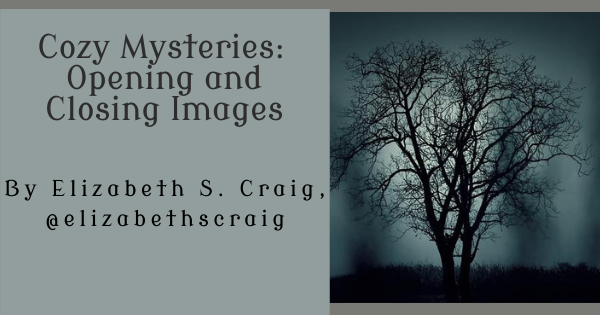by Elizabeth S. Craig, @elizabethscraig
After writing about fifty cozy mysteries, I think I’ve used just about every story opener possible. I’ve opened with the dead body a few times. Sometimes I’ve had just a few pages of set-up and then a body. Sometimes I’ve had the annoying future victim interact with the irritated future suspects and then the victim about 30 pages in. They all seemed to work for the story, in different ways.
Although I never worried about beginnings (often choosing to open with dialogue and just hop right in), the endings of my books were always a bit more of a struggle for me. The moment of danger for the sleuth was over. The police had arrived and taken the bad guy/gal away. Everything else seemed a bit anticlimactic.
Having the ending reflect the beginning works particularly well for a cozy mystery, I think. A nice bonus is that it helps nicely with tying up the troublesome endings of my books. With this method, I’ll often open my stories with a brief scene of a perfect version of the story world. My characters are happily ensconced in their safe, cozy world. They’re working crosswords and drinking coffee. Or they’re eating tomato sandwiches and watching their favorite soap opera.
I’ve written before about my “quiet beginnings” for cozies and how the mirroring technique can help establish that. But I didn’t really mention much about how it plays into the endings and make them both stronger and easier to write.
Mirroring works well for other genres in different ways. It’s often touted as a great way to remind readers of character growth. Janice Hardy has an excellent article on this technique.
With cozies, I think it serves a slightly different purpose (of course, you can use it to indicate protagonist growth, too). In the example I gave above, it’s all about the comfort of the repeating scene. . . creating a tableau and then pulling it together again at the end. You’re bringing back the peace and harmony at the end of the story. It’s a very pleasing, tidy process. Return your protagonist back to the safety and security of the opener.
For more thoughts about creating cozies, here are the other posts I’ve written in the series.
How do you handle story openers and closings in your books?
Writing the Cozy Mystery: Opening and Closing Images: Share on XImage by SplitShire from Pixabay

Thanks for the tips on how to begin and end a cozy mystery series. I can see why it might be hard to end the story. I’ll have to start paying more attention to how you and other writers end the story. It’s different than in genres like fantasy, where you’re probably writing a series.
In some ways I think it would be trickier to end a fantasy, especially considering a writer needs to wrap-up some storylines while leaving others open. But wrapping up a cozy can seem really anti-climactic, so it’s tricky, too.
You make a really good point about the ending and beginning reflecting each other, Elizabeth. I think that gives the reader a sense of closure about the story, and a sort of resolution of the plot. I also think it’s a good way to help the author tie up those ‘loose ends’ and make sure that the journey to the end makes sense. There’s just something satisfying about it, possibly because it restores a sense of order?
You’re so right: it creates a restoration of the norm in the little town and a real sense of order.
Interesting. I’m trying to imagine how that would work in a romance…
Usually the characters go from discontent in the beginning to content in the ending rather than life interrupted. I like to foreshadow the character arc in the opening. Reveal the characters tragic flaw and then close with him or her fixing it. That’s kind of a mirror.
I think a mirroring effect would work well. :) Especially since you’d have one person in the situation at the beginning and two people in the situation at the end.
Hi Elizabeth – Late – but here … and interesting to note the mirroring technique – I must say when I’ve read a book, which I’ve enjoyed, and then the ending completely lets me down … I feel like the author has got bored … and it is so necessary to tie things up to complete the story or article or post. Thanks for this – makes so much sense – cheers Hilary
Thanks for stopping by, Hilary! Yes, it’s definitely a nice technique to give that “completed” feel to a story.